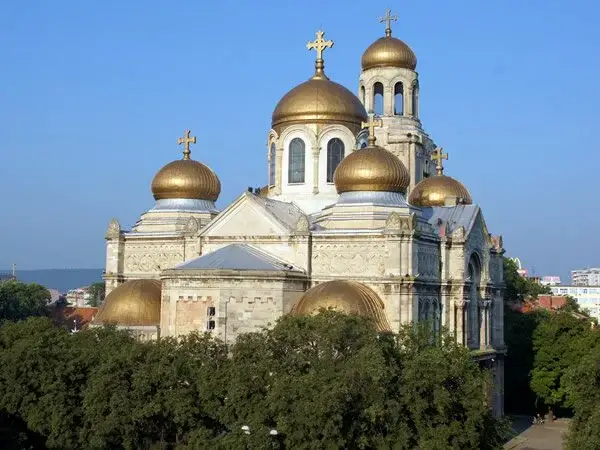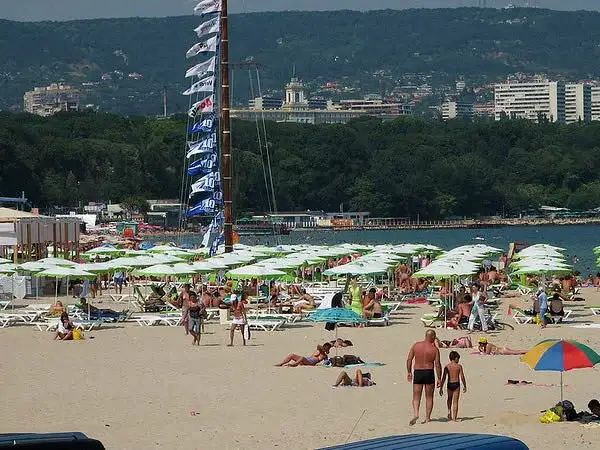

Varna is one of Bulgaria’s sun and beach destinations and an ideal starting point to visit and get to know the northern Bulgarian Black Sea coast.
With almost 350,000 inhabitants, it is the third largest city in the country and probably the most interesting and cosmopolitan city on the Bulgarian coast.
In 1972, on the northern shore of Lake Varna, the Varna necropolis was discovered. It dates back to the second part of the 5th millennium BC and is an important piece of evidence of a developed civilisation in southern Eastern Europe. More than 3000 gold tools with a total weight of 6.5 kilograms have been found there and are considered to be the oldest cultivation of gold in the world.
In Varna, the Greek and Roman presence in the area has left an interesting legacy of monuments worth visiting. The Roman Baths complex (Rimski Termi) in the heart of the historic centre is not to be missed. The Cathedral of Sv. Bogoroditsa is the second largest in the country and was built in the late 19th century to commemorate the Russians who died defending Bulgaria from the Ottoman enemy.
A strange but harmonious combination of port city, naval base and seaside resort, it is an attractive place to spend a few days steeped in history but surrounded by modernity, with a huge park to wander around and a long beach to laze on.
Away from the capitalist crowds, Varna boasts a number of less obvious attractions, such as several art galleries, a dolphinarium and Bulgaria’s only naval museum, while the city is also the ideal base for excursions to nearby resorts such as Sveti Konstantin and Golden Sands (Zlatni Pyasatsi), and the charming towns of Balchik and Dobrich.
Sailors in dress uniform on the waterfront mingle with foreign and local tourists as they stroll along the shady boulevards lined with dignified 19th and early 20th century buildings. Ancient, medieval, Renaissance and modern cultures mingle and coexist in the city. Of the abundant green areas, three are a must-see: the Maritime Gardens, which are the largest in the Balkans, Euxinograd Park, the former Royal Palace and St. Constantine’s Paradise.
Varna competes with the larger cities of Sofia and Plovdiv in its offer of cultural attractions and historic buildings, museums and art galleries. It also offers access to some of the quietest and most scenic places along the coast, including the Kamchiya nature reserve, the Royal Palace of Balchik and the Aladzha Monastery.
In 1972, on the northern shore of Lake Varna, the Varna necropolis was discovered, which dates back to the second part of the 5th millennium BC and is an important piece in the world of prehistory. The discovery proves the existence of a developed civilisation in southern Eastern Europe. More than 3000 gold tools with a total weight of 6.5 kilograms have been found there and are considered to be the oldest cultivation of gold in the world.
Varna Necropolis
In the western part of Varna, a prehistoric necropolis of world importance is located only a few kilometres from the lake of the same name. Discovered by accident in 1972, expeditions are still continuing, with an estimated 30% still to be uncovered. This cemetery of approximately 4,600 to 4,200 BC would belong to the Chalcolithic Varna Culture, and has 264 tombs with sophisticated gold, copper, stone and pottery items inside. What is captivating is the quality, the workmanship must have been paramount for such an ancient culture, among which the objects made of flint and obsidian stand out.
A curious fact is that many of the tombs are empty, and in their place funeral gifts have been found. Nearly 3000 objects have been found in these tombs, some made of unfired clay, and others with more gold than has been found in any other contemporary culture, revealing a hierarchical order respected even in death. One of the tombs is so lavish with gold that it has even been used as a penis sheath for its owner’s penis, believed to be a veneration of virility and bravery.
There is no evidence that the artefacts were not made by local craftsmen. Their remains also reveal an intense commercial life even in distant lands; they may have reached as far as the Volga.
The surrounding remains show a lack of cultural continuity in the area, similar to cultures such as Karanovo, Lengyel and Vinca, for which scholars have yet to find an explanation, whether it was a catastrophe, an epidemic or just climatic changes that caused the inhabitants to migrate.
Thanks to these remains, it has now been definitively ruled out that nomads were the ones who put an end to the Copper Age society in the Balkans. The Varna complex demonstrates a socio-cultural apogee evidenced by its metallurgy, luxurious artefacts and funerary customs, as well as the expansion of agriculture in surrounding communities. It is above all the Varna gold that has been recognised worldwide since 1973 in a travelling exhibition in the most important museums of the world.
Varna was promoted as the first European civilisation by appearing in documentaries and covering the cover of National Geographic. Nowadays, for the hardened historian it is necessary to travel to the site museum to enjoy the beauties kept there, a good pretext to get to know this hidden side of European history, the origins of which lie more on the eastern side.
How to get from Sofia to Varna
- Bus: The bus journey from Sofia to Varna takes about 7 hours.
- By car: it is advisable to take the A1 highway, passing through Plovdiv and also passing near Burgas. The journey takes about five hours.
- Train: The journey by train from Sofia to Varna takes about 7-8 hours.
- By air: There are flights between the capital and Varna every day of the week. Search for flights to Varna.

